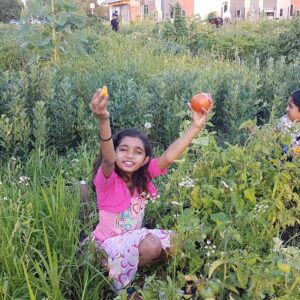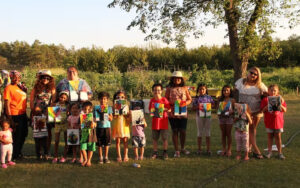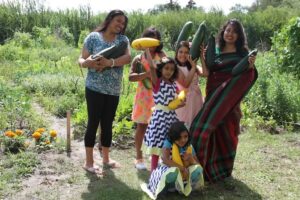 A number of years ago, ten families (including mine) started a small community garden in Saskatoon. We had ten garden plots and gardeners from three different countries. We invited nearby residents to participate. Many of them lived in the University of Saskatchewan campus-owned apartments.
A number of years ago, ten families (including mine) started a small community garden in Saskatoon. We had ten garden plots and gardeners from three different countries. We invited nearby residents to participate. Many of them lived in the University of Saskatchewan campus-owned apartments.
Given that the poverty around us includes a lack of affordable nutritious food and is compounded by community isolation and culture shock, we wanted to build a cross-cultural, environmentally sustainable garden community. With our desire to engage with food sovereignty and reconciliation, we hoped to engage Indigenous Peoples, racialized minorities and non-visible minorities to talk about reconciliation and decolonization.
The Food and Agriculture Organization (FAO) of the United Nations calls food sovereignty “a basic human right.” It is the right to access healthy food and to control food policy.
We wanted to create a shared space where children and adults could grow their own food and also learn how to create food security in our community. We planned to share what we learned with larger communities.
By starting small and working steadily, we were able to grow our garden and, along with that, our knowledge and our cross-cultural community. Many children were there daily, especially during weekends and in the summer, when schools were closed.
We used a participatory action style of research which involves the community, and published the results in the Local Environment journal. Based on our study, I believe cross-cultural land-based activities can make positive changes in an urban environment.
Land-based learning is a process of learning how to build relationships with land, Indigenous people, insects, plants and animals. The insights from the garden collective also provided valuable information for educators, especially those who are interested in incorporating land-based learning as well as those who hope to create a sense of belonging in cross-cultural communities. Ultimately belonging and land-based learning leads to community empowerment.
Indeed, providing the space and educational resources for our community to grow food had incredible impacts. Our garden space grew to 120 garden plots with more than 25 countries and cultures represented.
Membership bloomed to 400 adults and 60 children. Another six sharing plots were created. Two plots were for sharing food with local people, two for students and two for neighbours without access to garden space.

Art activities at the Saskatoon Community Garden
Food insecurity
Our community garden also plays a significant role in food security and food sovereignty.
Indigenous people, international students, immigrants and refugee families are particularly vulnerable populations that experience a lack of sustainability for various reasons, including lack of belonging and networks, low income, mental stress and discrimination.
Food insecurity within immigrant and refugee communities in North America is a significant challenge. New immigrants and refugee communities experience higher rates of food insecurity than any other community in North America.
Our summer garden activities and engagements with the food production system helped to ensure food sovereignty.
One gardener commented: “We could not afford to buy fresh vegetables from the superstore. I was sad for our children that they are not getting enough nutrients due to poverty. However, the community garden gave us the access to organic, fresh vegetables. We could preserve our home-grown vegetables for six months.”
As a community, we found a way to think about and work towards localizing food systems, valuing food producers, engaging with nature, and making decisions locally.
Reconciliation and cross-cultural understanding
Our community garden offers tangible strategies for newcomers (including immigrants, refugees, non-immigrants from Indigenous and non-Indigenous communities, and other vulnerable or marginalized populations) to build community and community connections. This included building relationship with Indigenous land-based knowledge, culture and practice, and accepting accountability for unlearning and relearning as a continuous process of reconciliation. It also meant building a transnational community by challenging the issues of class, caste, gender and ethnicity that regulate our home away from home.
 We learned that cross-cultural community garden activities are a good way to forge relationships. By working together in the community garden, members of different communities are able to transfer their knowledge to each other, which gives them a better understanding of one another.
We learned that cross-cultural community garden activities are a good way to forge relationships. By working together in the community garden, members of different communities are able to transfer their knowledge to each other, which gives them a better understanding of one another.
As coordinators, we initiated many cross-cultural participatory activities (singing, dancing, recitation, sharing positive experiences about gardening, etc.). Our gardening activities included informal educational workshops and social events that attracted many volunteers, educators, Indigenous Elders, as well as scholars from the University of Saskatchewan.
For example, our community garden’s year-end cross-cultural Harvest Potluck demonstrated to us that celebrating traditional foods is an important way to connect with culture and create a sense of belonging. As well, our annual Harvest Festival exposed the surrounding community to many of the world’s different cultures as people share their diverse food heritages.
As new immigrants to Canada, my family and I were inspired by a love and appreciation for the process of gardening, and also by the cultivation of community. Having cross-cultural activities in a garden, where we go to educate ourselves and others about how we can live together within different cultures, helps us to understand and respect each other.
All photos courtesy of Dr. Ranjan Datta.
This excerpt is part of an article originally published on The Conversation website, shared here under a Creative Commons license.







